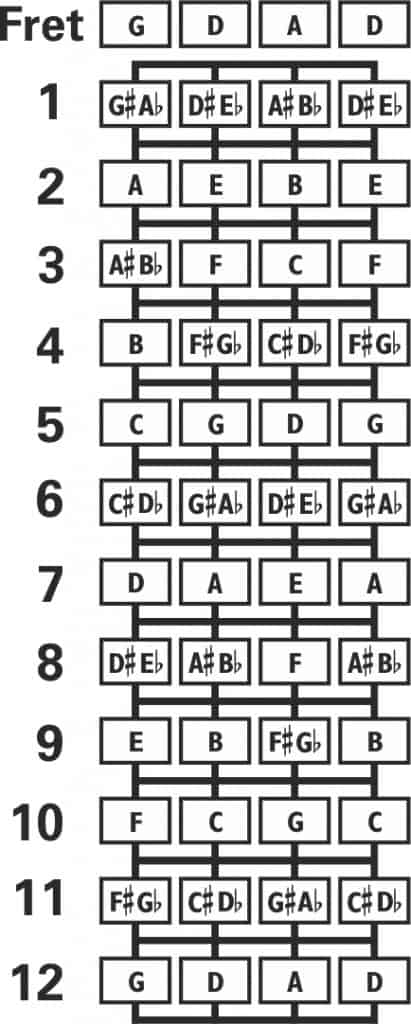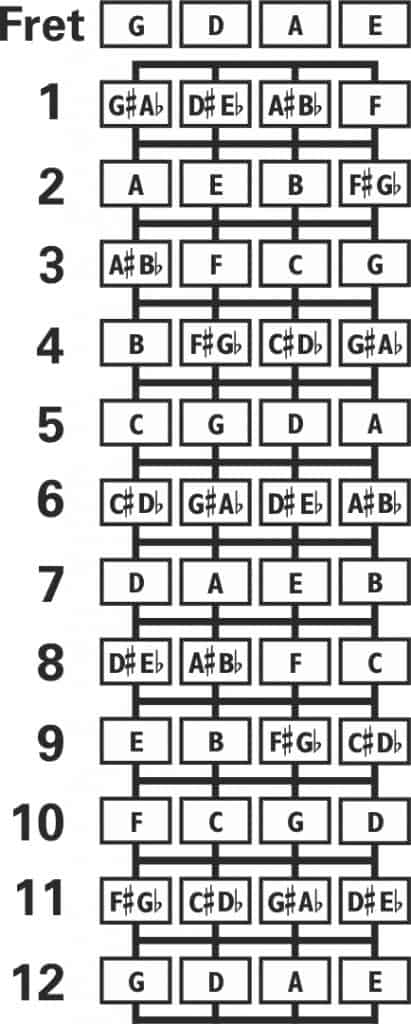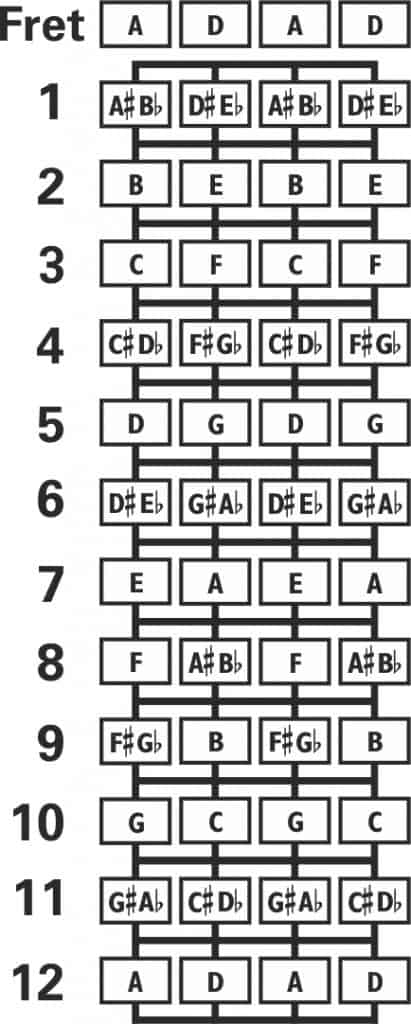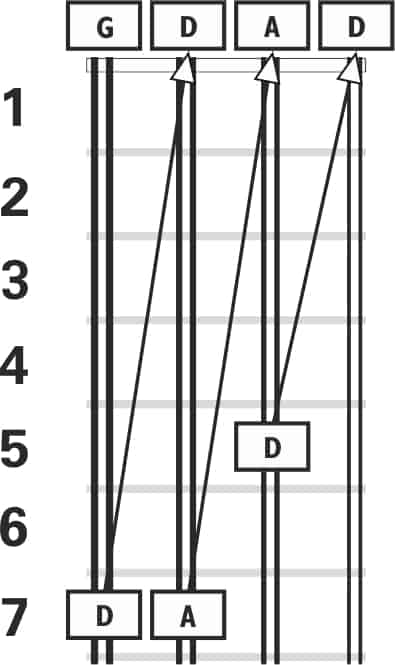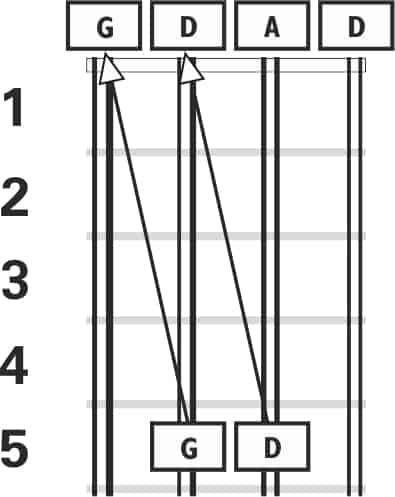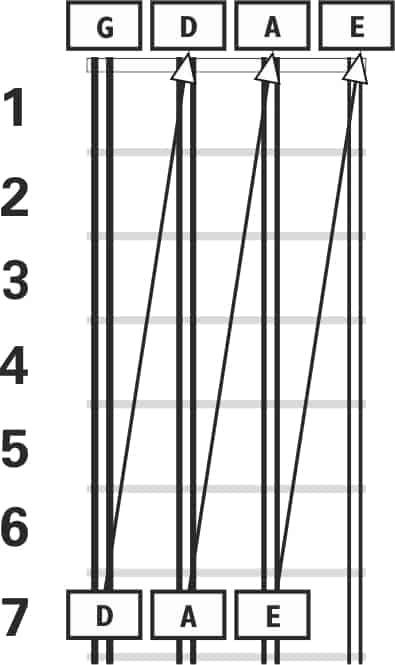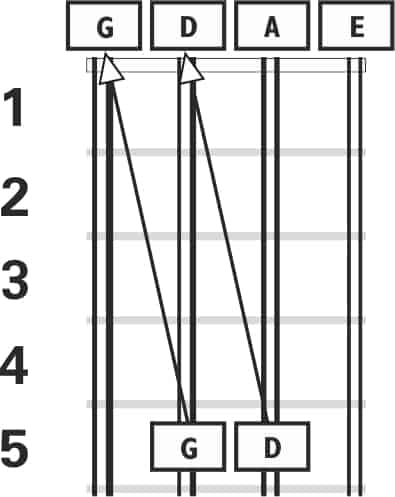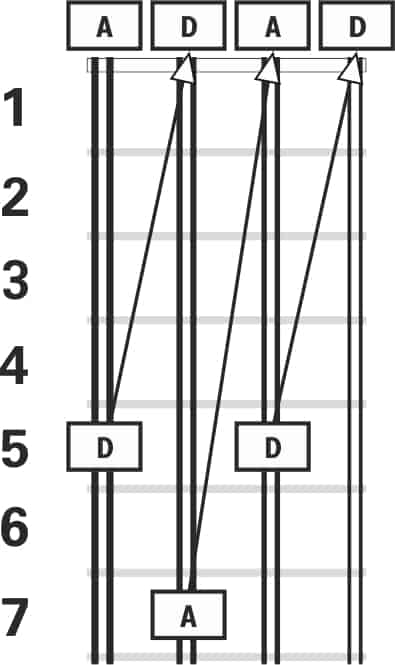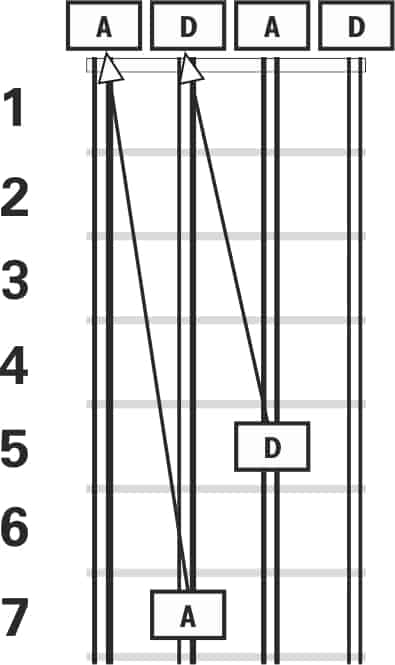Many people come to the Irish bouzouki from a more established instrument such as the guitar or mandolin.
The learning curve, however, shouldn’t get you running for the hills in trepidation!
Like a number of other fretted instruments such as the 12-string guitar, mandolin, and mandola, the Irish bouzouki features sets of strings that are arranged in double pairings.
This gives the instrument its recognisable ringing tone. The arrangement of the strings can be set up in two basic ways:
- As unisons, where each pair of strings is tuned to the same note in the same octave; or
- As octaves, where the final two string pairings are tuned to the same note an octave above or below each other.
With both stringing configurations, the first two string pairings are always unisons.
If you’re new to fretted instruments the first string is the one furthest from your chin. The last one, in the case of the bouzouki (the eighth string) is nearest to your chin.
This applies whether you’re right or left-handed. In practice, whether you choose unisons or octaves is down to personal taste, but a beginner probably shouldn’t worry too much about this aspect of stringing until he or she has learned the basics.
Tip: If you’re a serious player, you might be interested in the two chord bibles I wrote solely for the Irish Bouzouki, available in both GDAD and GDAE tunings.
Covered in this Article:
What is Standard Tuning for an Irish Bouzouki?
Although standard tuning is a debatable term on the bouzouki, it’s arguable there are three popular configurations that most players like to employ:
GDAD Tuning
The most popular is GDAD, which is my own personal favourite. In chordal parlance, this gives the instrument an open Dsus4 (D suspended fourth) an archetypal modal sound much loved by many folk musicians.
With octave tuning, the last two pairs of strings, the G and D are each tuned an octave apart.
GDAE Tuning
The next most widely used tuning is probably GDAE, the reason being, it mirrors standard tuning on both the mandolin and octave mandolin.
This is ideal if you’ve decided to diversify away from either of those popular instruments and don’t wish to re-learn all your basic chord structures.
My only gripe with GDAE is it doesn’t give you that typical modal sound associated with the instrument.
I would equate it with somebody wishing to transition from the guitar to the banjo, but not having the time or inclination to relearn everything – they might well opt for a 6-string guitar banjo instead (an instrument that looks and sounds like a banjo, but is strung like a guitar).
GDAE is a good option, regardless of the reason for choosing it as well, as the chords are a little easier, in my opinion.
ADAD Tuning
Finally, if you want a true modal tuning (an open string arrangement, that is neither major nor minor), a third option is to consider ADAD.
This is basically a D5 or D power chord in the open string position, for the guitar players amongst you.
Irish Bouzouki Tuning: How to Tune Your Irish Bouzouki
Here, I’ll run through GDAD, GDAE and ADAD tuning for the Irish Bouzouki, and the ways of going about it.
To provide the most accurate tuning for your bouzouki, your first and simplest option should be the purchase of an electronic chromatic tuner, such as the ones I recommend from the Snark range.
This will make your life a lot simpler, as you no longer have to rely on your ear for tuning accuracy.
The majority of tuners clip onto the headstock of your instrument and will pick up the vibrating frequencies of each string. Most run on one or two standard circular flat cell batteries.
An alternative way of tuning your ‘zouk’ is to tune it directly from a digital piano or keyboard instrument.
This still requires the need for a decent ear to achieve a reasonable level of accuracy, but for most people, it’s surprising how nuanced the human ear can be with regard to hearing different frequencies.
The easiest way to follow this method is to depress the sustain pedal on your piano or keyboard while you strike the key on the keyboard and as the note sustains tune up the string in question.
This saves you having to constantly re-play the note until you achieve the correct tuning. An acoustic piano is an alternative, but unless it’s regularly tuned, it’s unlikely to be as accurate.
Thirdly, you can tune your bouzouki to a guitar if it has an inbuilt tuner. Again, this still requires a reasonable ear to play the notes on the guitar and copy the corresponding notes onto the bouzouki.
See figures below for tuning your Irish bouzouki to a piano, keyboard or guitar:
How to Tune an Irish Bouzouki to a Guitar or Piano
GDAD Tuning

GDAE Tuning

ADAD Tuning

Finally, there are lot of internet sources or apps which will play a good representation of the notes needed to tune your bouzouki.
This should be applicable to most devices, including a regular PC, laptop, iPad or cell phone.
How to Tune an Irish Bouzouki to Itself
An alternative method of tuning your instrument, if you can get the first note, is to tune the bouzouki to itself.
This process is achieved by fretting at given positions on the fretboard/fingerboard. This requires you to generally tune the lowest note/string first.
In the case of GDAD for example, you tune the G string/s up to the correct pitch (strings 7 and 8). Then you fret that string on the 7th fret.
This gives you the tuning for the lowest D string (strings 5 and 6). Repeat the same method and fret this string, again on the 7th fret for the A.
Finally, to achieve the high D string/s, fret the next string (the A) on the 5th fret. See figures 2a, 2b and 2c for the correct fret positions for the three tunings.
When you’re tuning your octave strings using the above method, tune the lowest string first and then fret that same string on the 12th fret.
Alternatively, you can fret on the next string down (figs. 2b, 2d and 2f) to get the octave note. These fretting positions will give you the octave string notes on the two lowest courses.
See below:
GDAD Unison Pairs (left), and GDAD Octave Pairs (right)
GDAE Unison Pairs (left) and GDAE Octave Pairs (right)
ADAD Unison pairs (left) and ADAD Octave Pairs (right)
Note:A ‘course’ describes the number of strings on each single, double or triple note sharing strings.
For instance, a regular guitar is a single course instrument, the bouzouki and mandolin are both double course instruments and the tiple (a sort of multi-stringed ukulele) features triple courses on some of its strings.
Notation for Tuning an Irish Bouzouki
Note that the notation diagrams are pitched exactly one octave above ‘actual’ tuning. This negates the need to use the bass clef.
GDAD


GDAE


ADAD


Why does my Irish Bouzouki keeping going out of tune?
If you’ve recently installed a new set of strings on your instrument, it can take a few days for them to properly bed in and settle, tuning-wise.
It can help to stretch the strings after you’ve tuned up to pitch, by gently pulling them away from your bouzouki at the perpendicular angle, rather than up or down.
This will help to gradually stretch the string and should result in less extreme changes in stability. That being said, it’s still likely to need a few days to properly stabilise.
If this happens at a gig for example and you’ve had to change strings fairly quickly, you may well have to re-tune between numbers.
Another factor in the tuning going off on a regular basis can be put down to sudden climatic changes or if you live in a particularly hot or arid region of the world.
A humidifier can help enormously with such an issue. I recommend a humidifier like this complete system – a wise investment if this is likely to be a problem for you.

Another reason for tuning instability can be caused by transportation via road or air travel.
Changes in pressure, temperature and vibration are the likely culprits. There’s not a lot you do about that, but may well be a temporary issue until you’re solidly planted on terra firma!
One important point is to invest in a decent hard case for your instrument, particularly if you’re doing a lot of traveling to and from gigs or via plane. This will keep it safe from some of the problems associated with traveling.
Octave Designations for Irish Bouzouki Strings
Each entry features Scientific Pitch Notation for The Acoustical Society of America (ASA) and Helmholtz.
If you’re wondering what the best strings are for an Irish Bouzouki, I recommend this set by D’Addario.
GDAD
1st & 2nd string: D4 / D4 or d’/ d’
3rd & 4th string: A3 / A3 or a / a
5th & 6th string: D4 / D3 or d’ / d
7th & 8th string: G3 / G2 or g / G
GDAE
1st & 2nd string: E4 / E4 or e’/ e’
3rd & 4th string: A3 / A3 or a / a
5th & 6th string: D4 / D3 or d’ / d
7th & 8th string: G3 / G2 or g / G
ADAD
1st & 2nd string: D4 / D4 or d’/ d’
3rd & 4th string: A3 / A3 or a / a
5th & 6th string: D4 / D3 or d’ / d
7th & 8th string: A3 / A2 or a / A
See below for the correct octave designations on a standard 88-note piano keyboard:

Scientific Pitch Notation for the Irish Bouzouki
Every note in the full musical scale has a designated name attached to it. To give you an example, the ‘C’ note in the middle of virtually every piano in existence is described as a ‘C4’.
This tells you the note and which octave it should played in. Confusingly, two systems are extensively used, but which you choose doesn’t really matter.
The first was created by The Acoustical Society of America. It uses the numbering system which I’ve briefly described above.
The second is Helmholtz, a labelling system using a combination of upper and lower case note names, combined with apostrophes.
Again, using middle ‘C’ as an example, in Helmholtz it would be written as c’ (lower case c with an apostrophe). Helmhotz is named after German scientist, Hermann von Helmholtz, who originally devised the system.
Another useful piece of information to know about music is that every octave has a specific name.
These loosely tie in with the ledger lines on a musical stave or staff.
Here’s a list of the octaves from a standard 88-note piano ranging from lowest to highest, using the key of C as an example, along with the corresponding ASA and Helmholtz octave designation abbreviations:
Sub-Contra Octave (C0 or CCC)
Contra Octave (C1 or CC)
Great Octave (C2 or C)
Small Octave (C3 or c)
One-Line Octave (the middle ‘C’ octave) (C4 or c’)
Two-Line Octave (C5 or c’’)
Three-Line Octave (C6 or c’’’)
Four-Line Octave (C7 or c’’’’)
Five-Line Octave (C8 or c’’’’’)
I hope this article helps you tune up your Irish Bouzouki, and troubleshoot any issues you’ve had with tuning it.

